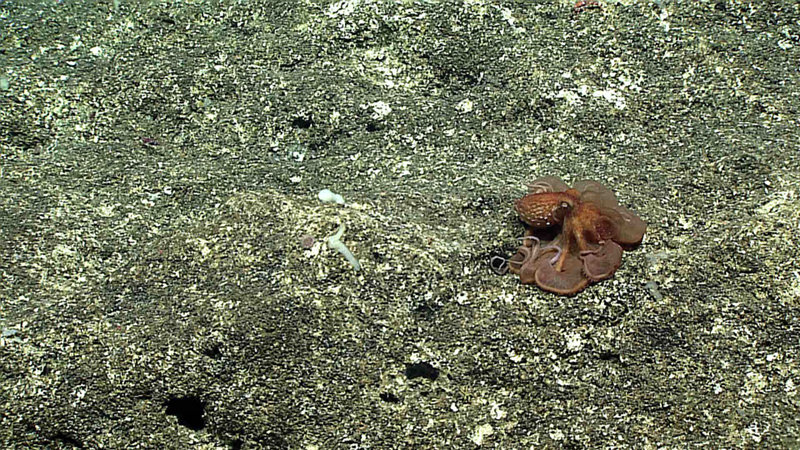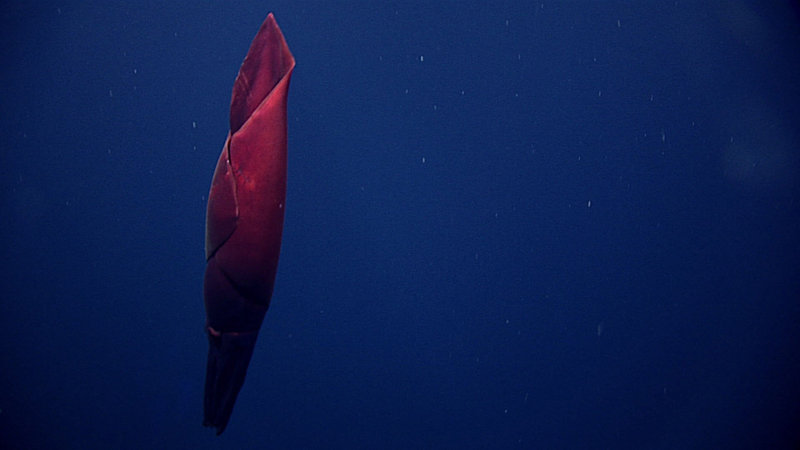
By Mike Vecchione - NOAA Systematics Laboratory, National Museum of Natural History
July 8, 2016
Detailed imagery, such as this from ROV Deep Discoverer, allows scientists to see the details of the external features of an organism. Aside from behavioral observations, in situ imagery helps us document what the organism looks like when it is alive and prior to any damage that might occur during the sampling process. Getting to see these organisms at all in their natural habitat is rare...we got lucky! Video courtesy of NOAA Office of Ocean Exploration and Research, 2016 Deepwater Exploration of the Marianas. Download (mp4, 26.4 MB).
The remotely operated vehicle (ROV) Deep Discoverer (D2) has excellent imaging capabilities. It has documented many discoveries with detailed close-up, high-definition videos and frame grabs.
Now that we have such great eyes in the deep sea, some people wonder why we need to collect specimens any more. A good example of the problems we face as biologists involves the bottom-dwelling octopods encountered during the Marianas expedition. These charismatic animals have been seen on several dives at the intermediate depths that we refer to as “bathyal” or slope-depth. This is the benthic equivalent of the mesopelagic, or “twilight zone,” in midwater, where very dim sunlight penetrates during the day.
Because I am interested in any cephalopod, anywhere, anytime, and because I am supposed to be an expert, I got excited by these encounters and tried to identify the species. Their general appearance was similar in many ways to an Enteroctopus, the genus of the giant Pacific octopus (GPO). That sort-of made sense.

The first dive of the expedition fell on #OctopusFriday, and we were not disappointed at our dive on Farallon de Medinilla. This octopus didn’t stick around long, but it offered us a brief glimpse of how octopods move across the seafloor. Image courtesy of the NOAA Office of Ocean Exploration and Research. Download larger version (jpg, 1.8 MB).
Although the Marianas are pretty far south, GPOs are known from the west coast of North America to Japan, and at the southern ends of that range they are found at depths similar to these observations. However, close-ups revealed detailed physical characteristics that did not match the GPO. In fact, the skin was more like a typical Octopus, which is in a different family.
I therefore contacted several colleagues around the world who have more experience with deep benthic (bottom-dwelling) octopods from this part of the Pacific. The consensus was that we cannot identify these animals, even to family, just with photographs or videos. We need to be able to examine details such as sucker counts, internal organs, sexual development, etc., none of which can be done from a video record.
Unfortunately, D2’s sampling capabilities are not currently adequate for collecting mobile animals like octopods, so we will have to settle for observing their external appearance and in situ behavior for now. It does appear though that at least two species may have been encountered, possibly separated by depth.

This gorgeous squid, probably Taningia danae, was seen as Deep Discoverer was descending to the seafloor. Image courtesy of the NOAA Office of Ocean Exploration and Research. Download larger version (jpg, 517 KB).
Couldn’t we figure out what they were from DNA without collecting the specimen? No -- for several reasons. First, we don’t yet have a remote method to take a non-lethal tissue sample from such animals, as can be done with whales and some terrestrial organisms. Second, it is likely that these octopods include one or more species that are new to science; therefore, their DNA sequences would not be available for comparison in a database. And third, if they are undescribed species, we need more biological information than just their genetics to understand where they fit into their ecosystem and the evolutionary tree of life.
This is part of a broader debate in biology about the necessity of collecting specimens. A recent essay by Minteer et al. in the high-profile journal Science suggesting that new technology should be considered an alternative to collecting generated immediate responses by a broad spectrum of biologists, such as Rocha et al. demonstrating that specimen collection is still very necessary for biology.
Thus, the 2016 Deepwater Exploration of the Marianas expedition has allowed a brief glimpse at a deep ecosystem that we now know is inhabited by cool octopods. The next job is to figure out what they are, to whom they are related, and how they fit into the ecosystem.
This octopus observed at Ahyi scurried across the seafloor to get away from the vehicles, but it seemed to be a little too curious to completely disappear from view. Video courtesy of NOAA Office of Ocean Exploration and Research, 2016 Deepwater Exploration of the Marianas. Download (mp4, 25.7 MB).